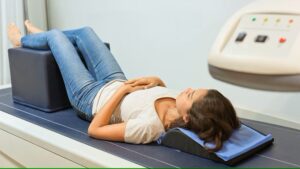Bone Density Scan (DEXA scan)
 How is it performed?
How is it performed?
A bone density scan is a quick and painless procedure that involves lying on your back on an X-ray table so an area of your body can be scanned. No special preparations are needed. You may be able to remain fully clothed, depending on the area of your body being scanned. But you’ll need to remove any clothes that have metal fasteners, such as zips, hooks or buckles. In some cases, you may need to wear a gown.
When you have a DEXA scan you lie on your back on a flat, open X-ray table. You’ll need to keep still during the scan so the images are not blurred. The scan will usually be carried out by a radiographer, a specialist in taking X-ray images. During the scan, a large scanning arm will be passed over your body to measure bone density in the center of the skeleton.
As the scanning arm is moved slowly over your body, a narrow beam of low-dose X-rays will be passed through the part of your body being examined. This will usually be your hip and lower spine to check for weak bones (osteoporosis). But as bone density varies in different parts of the skeleton, more than one part of your body may be scanned.
The forearm may be scanned for certain health problems, such as hyperparathyroidism, or if scans are not possible in the hip or spine. Some of the X-rays that are passed through your body will be absorbed by tissue, such as fat and bone. An X-ray detector inside the scanning arm measures the amount of X-rays that have passed through your body.
This information will be used to produce an image of the scanned area. The scan usually takes 10 to 20 minutes. You’ll be able to go home after you have had it done.
Your results
A bone density scan compares your bone density with the bone density expected for a young healthy adult or a healthy adult of your own age, gender and ethnicity. The difference is calculated as a standard deviation (SD) score. This measures the difference between your bone density and the expected value. The difference between your measurement and that of a young healthy adult is known as a T score,
